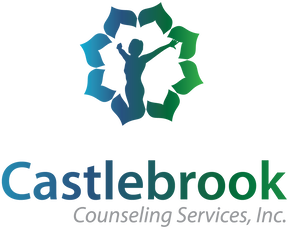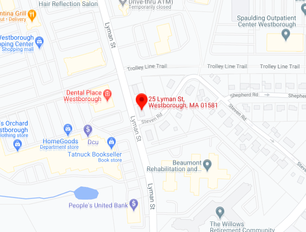Clinician Spotlight: An Interview with Niamh Smithers, M.A.Lauren Chapin, LICSW
Welcome to Castlebrook’s Clinician Spotlight series where I sit down with some of our wonderful therapists for a cozy conversation about work, mental health, and many life tidbits in between! Most recently, I got to know Castlebrook’s newest clinician, Niamh Smithers. Niamh and I explored what it’s like to be a newer therapist (she is a pre-licensed therapist working under the supervision of Castlebrook’s Dr. Valarie Clemente-Crain), her love for art and animals, and her passion for embracing all emotions, not just the “good” ones. Lauren: Hi, Niamh! As one of our newest clinicians, welcome to Castlebrook! What brought you here? Niamh: Although I had other interviews lined up, Castlebrook was the first place I visited in person. I immediately felt drawn to the physical space and the positive energy here. It made me hesitate, thinking I shouldn't just accept the first option I saw. However, as I explored other places, I just loved Castlebrook! The people here are more energized, the space itself is brighter and inviting, and when it came time to make a decision, choosing Castlebrook was a no-brainer. It had everything I was looking for to continue my growth. Lauren: You say that Castlebrook has what you’re looking for, what are you excited about while delving into this field? Niamh: I prioritized supervision and support when considering any job offer. No matter my confidence, knowing that I have a team to back me up with ideas and questions is invaluable compared to everything else that comes with a job. Interestingly, I had my own personal experiences with DBT four or five years ago, and I loved it. When I applied to Castlebrook and saw their focus on DBT, I was super fascinated and interested in becoming a clinician who incorporates DBT principles. While I have a lot of personal, niche area goals that I want to learn about, DBT is among them, and this team is packed with DBT gurus. Lauren: I love hearing about niche areas. What are some of those other pieces that you’ll be bringing to the table? Niamh: When I started in the field, I pigeonholed myself into working with certain diagnoses and age groups. However, when I found myself in an internship working with adults dealing with occurring disorders, I discovered that I had a lot of excitement and confidence about the recovery process, the ins and outs of relapse and recovery, and what that signifies in therapy. My ultimate goal is actually to offer art and animal-assisted therapy. No matter how deeply I’m struggling or what I’m going through, art and animals have always been my anchor down to the ground. I want to be able to bring that to people. The idea of art therapy to me, while there are many ways to interpret it, is that if someone is uncomfortable just sitting and having a conversation, using their hands to create art can actually promote deeper thinking. Personally, I was always more focused in school when I was doodling or keeping my hands busy. For many, traditional talk therapy can be really scary, so having something in between the talking can ease a lot of anxiety for people. Lauren: Absolutely, how else do you create these safe spaces for your clients? Niamh: Starting with the physical aspects, it can be challenging as a therapist to enter a space that doesn’t feel like yours with a client who is also nervous because that energy feeds off of each other. So, I brought in throw blankets, a sign that reads “you can do hard things,” and other personal touches to add to my office. I also plan to bring plants in (I worked at a garden center for 12 years). In terms of verbally creating a space, I’ve grappled with defining my style, but I’ve come to recognize that my style is very relational and conversational. I meet the person where they’re at. With my experience in community mental health, hotlines, and peer support, it gave me a lot of tools to immediately hold space for a person. I think I can be really authentic when I’m with a client, and that’s how I’m going to grow that space into the one I want to create the most. By consistently showing up as myself, a relational therapist, and as someone who is new and always learning, I will keep that space really sacred and open. Lauren: I’d love to hear more about the hotline work and some of your other background. Niamh: I actually started my undergraduate schooling in animal science before finding my way back to psychology. During my undergrad years, I worked at an art studio where I analyzed the work of an artist who struggled with severe mental illness and tried to understand what was being said through her art. I also practiced art therapy with adults with developmental disabilities. I was also able to bring my emotional support animal, helping clients focus by playing with my dog if they were feeling stuck. These experiences emphasized that everyone has unique needs, perspectives, and interpretations of the world. When I entered my master’s program, I was providing peer support through phone, in-person, and Zoom group sessions, sometimes handling up to six groups per day. It was a lot to manage people struggling while you were also cooped up in your house. That taught me a lot of patience and understanding. If people are still coming back and calling, there is something that they’re getting out of it. It taught me that my interpretation of progress might be different to how a client sees progress within themselves. A lot of this work was in crisis management and crisis stabilization, so I think my next step is focusing on deeper work and I see a lot of value in that. Lauren: Outside of work, what are your interests? How do you make sure you’re showing up as your best self? Niamh: Art has always been a big part of that. I’ve been an artist my whole life. My mom tells stories about me drawing before I could walk. I think the process of creating has always brought me comfort. I actually ended up taking my art, something that gives me a lot of support and solace, and started raising money with it for suicide prevention. Art can be very scary sometimes, especially a blank canvas. Being okay with creating and not worrying about the end result, the idea of progress not perfection, process not product, really helped me. I also love to sing, I am a very mediocre ukulele player to supplement my singing, and animals. I love animals. If I could adopt every animal I see outside, I would. Lauren: Is there anything else that you'd want a potential client to know? Niamh: Based on my previous professional experiences, I've had the most exposure to anxiety and depression, but my real jam is emotional regulation and emotional processing. Emotions are really hard and scary a lot of the time, especially because we’re told from a young age that certain emotions are “bad” and that we should only be happy. Everything is very black and white when you’re learning the basics of emotions, and then when you get to adulthood, everything is gray. My favorite thing is becoming friends with the “bad” emotions because emotions aren’t facts, they’re just directions on a road map. Just because you’re feeling mad, it doesn’t mean you’re an angry person. It only means something going on within or around you is not sitting well with your goals or authentic self. Giving room to pause and really sit with those difficult emotions is my favorite thing to do. Anyone willing to explore emotions is already doing half of the work. ****** At the time of this blog post, Niamh is accepting new clients. She is a pre-licensed clinician working under the supervision of Dr. Valarie Clemente-Crain here at Castlebrook. Please fill out the intake form to be contacted.
0 Comments
Your comment will be posted after it is approved.
Leave a Reply. |
Archives
May 2025
Categories |
Mission Statement
Castlebrook Counseling Services, Inc. is a group of private practice clinicians with a shared goal of strengthening our community by providing therapy and clinical support designed for children, adults, and families to successfully meet life’s challenges.
 RSS Feed
RSS Feed

